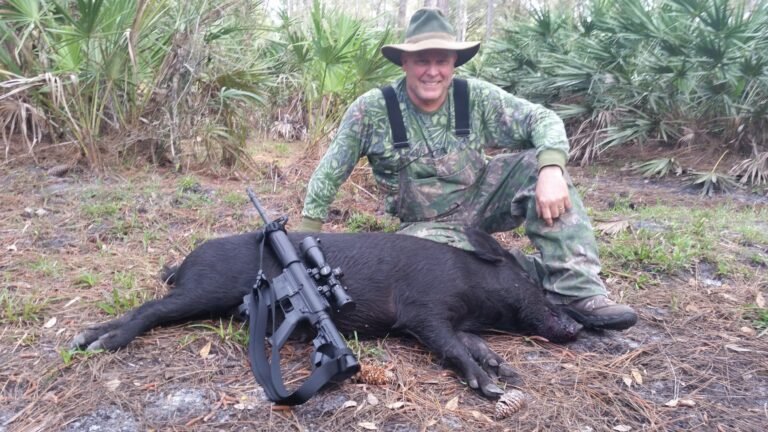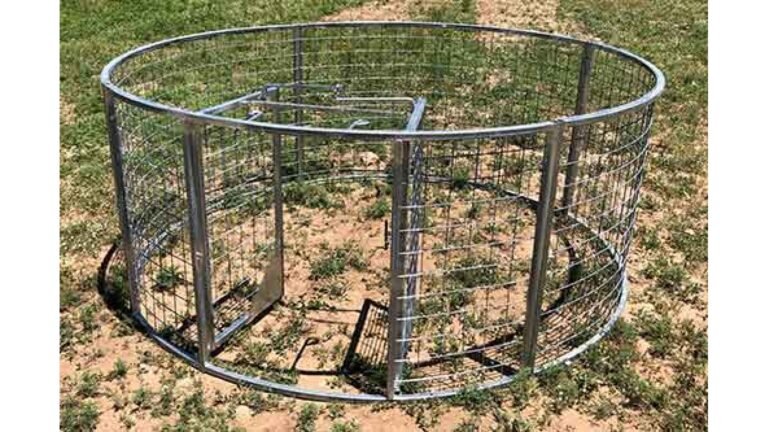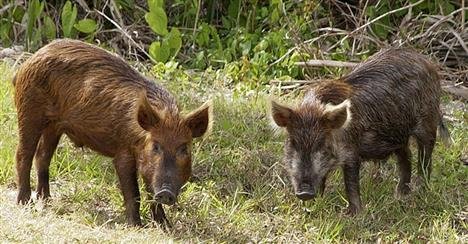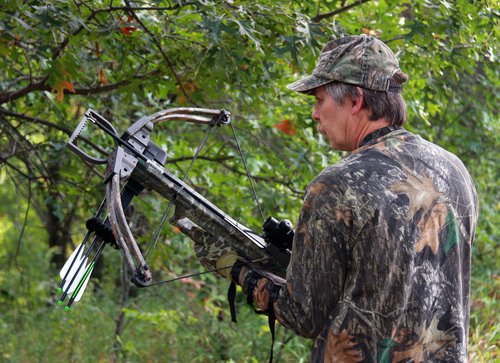The Hunter’s Edge: Best Knives for Hog Hunting Enthusiasts
Hog hunting is an exhilarating and challenging outdoor activity that requires precision, skill, and the right equipment. While firearms and tracking methods play a significant role in hog hunting, one cannot overlook the critical importance of knives and tools in this pursuit. From field dressing to processing the game, finding the essential knives and tools for hog hunting is paramount for every hunter.
Having a reliable set by your side can make all the difference regarding field dressing tools. The primary purpose of these tools is to assist in properly preparing the hog for transportation and consumption.
A comprehensive field dressing kit typically includes a skinning knife, gutting knife, bone saw, rib spreader, and disposable gloves. Each tool serves a specific purpose in efficiently removing the hide, organs, and bones while minimizing waste.
The selection of a suitable hog hunting knife should not be taken lightly. This versatile tool is vital for skinning, quartering, and even self-defense if necessary.
Factors to consider when choosing a hog hunting knife include blade length (typically ranging from 3-6 inches), blade material (such as stainless steel or high-carbon steel), handle grip (ergonomics and non-slip features), weight (for balance and ease of use), and overall durability. Blade materials play a crucial role in determining the performance and longevity of a hog hunting knife.
Stainless steel blades are highly popular due to their corrosion resistance properties while maintaining sharpness over time. High-carbon steel blades offer excellent edge retention but require regular maintenance to prevent rusting.
Some hunters prefer laminated or Damascus steel blades for their exceptional strength and aesthetic appeal. Maintaining your knives properly ensures they remain sharp during critical moments in the field.
Regular cleaning with warm, soapy water followed by thorough drying is necessary to prevent rusting or degradation of handle materials like wood or rubber grips. Also, honing your blade using sharpening stones or a honing rod before every hunt will ensure optimal cutting performance.
Knife sharpeners, such as whetstones or mechanical sharpeners, can be used periodically to restore the razor-sharp edge. Knives and tools are indispensable in the world of hog hunting.
Field dressing tools allow hunters to process their game while minimizing waste efficiently. The right hog hunting knife is essential, considering blade length, material, handle grip, weight, and overall durability.
Proper maintenance and sharpening of these tools will extend their lifespan and contribute to a successful and enjoyable hunting experience. So, ensure you’re equipped with the best knives and tools for your next hog-hunting adventure!
Field Dressing Tools: A Hunter’s Best Friends
Regarding hog hunting, field dressing tools are an indispensable companion for any hunter. These tools are vital in efficiently and effectively processing a harvested hog.
One of the most essential field dressing tools is the gut hook knife. This specialized knife features a curved and sharpened hook-like blade that makes opening the hog’s abdominal cavity easier without puncturing any organs.
Another must-have tool is the bone saw. This sturdy saw allows hunters to effortlessly cut through tough bones, making it a breeze to separate the hog’s limbs or remove the head if desired.
A quality bone saw should have sharp teeth that can easily grip and cut through bone without getting stuck or requiring excessive force. Additionally, having a reliable pair of game shears is crucial for snipping through joints, tendons, and other connective tissues while field dressing a hog.
These shears are designed to provide maximum cutting power with minimal effort, making them ideal for tasks like separating ribs or removing unwanted carcass parts. Last, no hunter should have a good set of latex gloves when field-dressing a hog.
These gloves protect your hands from blood and bodily fluids and help prevent cross-contamination between animals. They are disposable, inexpensive, and readily available at any outdoor supply store.
Field dressing tools are truly a hunter’s best friend in hog hunting. From gut hook knives that make opening up the abdomen effortless to bone saws that easily tackle tough bones, these tools ensure that every step of the process is efficient and precise.
When combined with game shears for clean cuts and latex gloves for hygiene purposes, you’ll be well-equipped for successful field dressing with minimal hassle. So don’t forget to invest in high-quality field dressing tools before your next hunt; they will make all the difference in ensuring an enjoyable and productive experience.
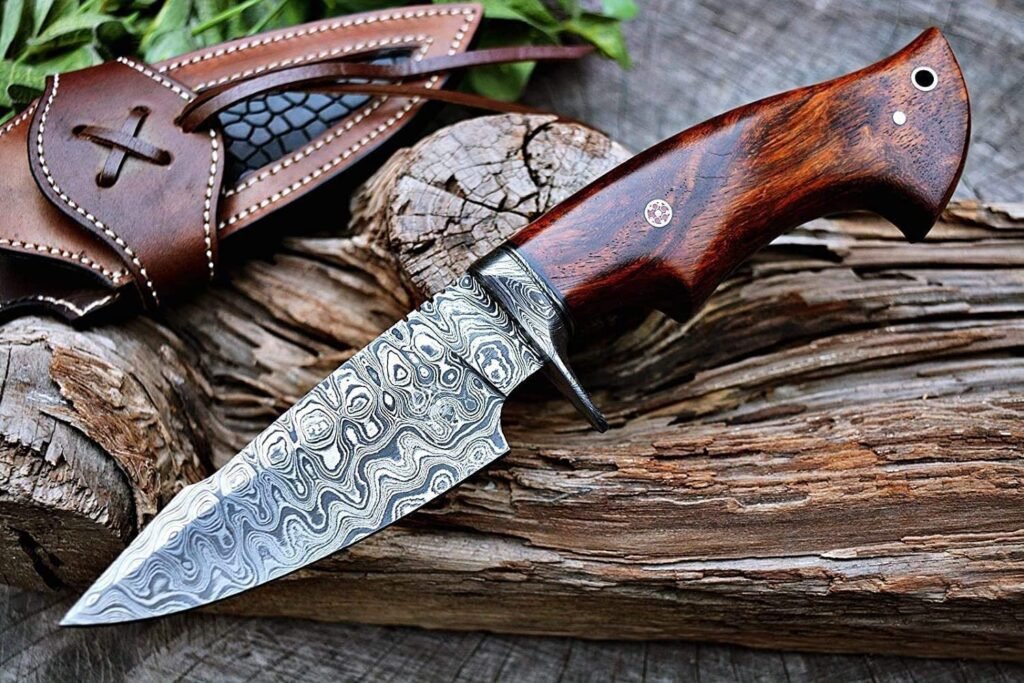
Types of Hog Hunting Knives
When it comes to hog hunting, having the right knife can make all the difference. Several types of knives are commonly used in hog hunting, each designed for specific purposes.
Let’s explore some of these types and their features. First up, we have the classic fixed-blade knife.
This type of knife is a favorite among many hog hunters due to its durability and versatility. The fixed blade design ensures no moving parts to worry about, making it reliable in the field.
These knives usually have a full tang construction, meaning the blade extends through the handle for added strength and stability. The blade length can vary, but for hog hunting purposes, a blade around 4-6 inches is ideal for precise cutting and field dressing.
Next on our list is the folding knife or pocket knife. Hunters who prefer a more portable tool favor this compact and convenient option.
Folding knives often feature a locking mechanism to keep the blade securely in place during use, ensuring safety while working with animals as unpredictable as hogs. They usually have a smaller length than fixed blades but offer ample cutting power for most field-dressing tasks.
Another popular choice among hog hunters is the gut hook knife. As its name suggests, this specialized tool has a small hook-like cutout on the spine near the blade’s tip.
This hook allows easy insertion into an animal’s abdomen without accidentally puncturing internal organs during gutting or field dressing. Gut hook knives are particularly useful when dealing with large game-like hogs because they simplify and expedite this essential step in processing.
Lastly, we have multi-purpose knives equipped with additional tools, such as saws or gutting hooks, integrated into their design. These versatile tools provide hog hunters with all-in-one solutions for various field dressing needs without carrying multiple separate tools into the woods.
When selecting your ideal hog hunting knife, consider blade material, handle grip, and overall comfort. Stainless or high-carbon steel is an excellent choice for blade materials as it offers durability and corrosion resistance.
Additionally, ergonomically designed handles with textured grips provide a secure hold even in wet or bloody conditions. Ultimately, the type of knife you choose for hog hunting depends on your personal preferences and the specific field dressing tasks you anticipate encountering.
A well-selected knife will make your hog hunting experience more efficient and contribute to a successful harvest. So, take your time to explore different options and find the perfect knife for your hog-hunting adventures.
Blade Materials and Construction
When it comes to hog hunting, your knife’s blade materials and construction play a crucial role in ensuring a successful field dressing experience. When choosing the right blade for hog hunting, let’s dive into some key aspects. First and foremost, stainless steel is a popular choice for hog hunting knives, and for good reason.
Stainless steel blades are known for their corrosion resistance, which is essential when dealing with the blood and fluids of game animals. You wouldn’t want your knife rusting away after just a few uses, would you?
Look for high-quality stainless steel options like 440C or S30V that also offer excellent edge retention. Another important consideration is the blade style.
A drop point blade is often recommended for hog hunting due to its versatility. This design features a strong, thick spine that gradually slopes to a sharp point.
The drop point excels in piercing through tough hide and precisely reaching vital organs during field dressing. Furthermore, blade thickness plays an important role in the durability and performance of your knife during hog hunting expeditions.
A thicker blade around 3-4mm provides the necessary strength to handle tough tasks like splitting ribs or cutting through cartilage without easily snapping or bending. The construction of the knife also deserves careful attention.
Look for full-tang knives where the blade extends through the handle, offering superior strength and stability during heavy-duty use. Bolstering or finger guards near the hilt can protect against accidental slippage while ensuring you maintain sufficient control over your knife.
Remember, when it comes to hog hunting knife selection, prioritizing quality materials like stainless steel and considering blade style and thickness will significantly enhance your field dressing experience. With a well-built knife, you’ll be better equipped to conquer even the toughest tasks that arise during hog-hunting adventures in pursuit of that perfect catch!
Essential Field Dressing Tools
Regarding hog hunting, having the right tools in your arsenal is essential for a successful field dressing process. Alongside a reliable hog hunting knife, you should consider adding several other field dressing tools to your kit.
These tools help make the task easier and ensure that you can efficiently and effectively process the harvested hog. One indispensable tool for field dressing hogs is a pair of heavy-duty gloves.
These gloves protect your hands from cuts and abrasions and help maintain hygiene by minimizing contact with bodily fluids. Look for gloves made from durable materials like nitrile or neoprene, which offer excellent puncture resistance while still providing dexterity.
Another vital tool is a bone or small saw specifically designed for game processing. This tool lets you easily and quickly remove the legs or separate larger bones during field dressing.
Opting for a folding saw with a lockable blade ensures portability while maintaining safety during use. A gut hook is another useful addition to your field dressing toolkit.
This specialized blade attachment on some knives allows you to open the animal’s abdomen without risk of puncturing the intestines or other organs. It simplifies the gutting process and helps prevent spoilage due to contamination.
Additionally, having a quality skinning knife can greatly facilitate the skinning phase of field dressing. Look for a knife with a curved blade specifically designed for this purpose.
A sharp and maneuverable skinning knife will enable you to effortlessly remove the hide while minimizing damage to the meat beneath. By equipping yourself with these essential field dressing tools, you’ll be well-prepared for any hog hunting expedition.
Remember that each tool serves a specific function, so consider their design, quality, and ease of use when building your collection. With these additional tools and an appropriate hog hunting knife selection, you can confidently handle every step of the field dressing process.
Knife Maintenance and Sharpening
Regarding hog hunting, your knife is not just a tool but your faithful companion. Keeping your hog hunting knife in prime condition is essential for optimal performance.
Proper maintenance and sharpening are crucial to ensure your knife is always ready for action in the field. First and foremost, it’s important to clean your hog hunting knife after each use.
Hog hunting can be messy, and blood, dirt, and debris can accumulate on the blade and handle. Use warm, soapy water or a mild detergent to clean the knife gently.
Pay extra attention to removing any residue from the blade, as it can affect its cutting ability. After cleaning, dry the knife thoroughly using a clean cloth or towel.
Moisture left on the blade can lead to rusting or corrosion over time. Once your hog hunting knife is cleaned and dried, it’s time to hone its cutting edge.
Regular sharpening will keep the blade razor-sharp for efficient field dressing. You have several options for sharpening tools – from traditional whetstones and diamond stones to compact sharpening kits specifically designed for hunters.
To achieve a sharp edge, start by holding the knife at an angle of about 20 degrees against the stone or sharpening device. Apply light pressure while moving the blade across the stone in smooth strokes, alternating sides until you’ve achieved a sharp edge.
Remember that different types of blades require different techniques for sharpening. Some knives may have a serrated section that needs special attention with a tapered diamond rod or ceramic sharpener.
In addition to regular cleaning and sharpening, proper storage of your hog hunting knife is also vital for its longevity. Invest in a quality sheath or pouch that will protect you and your knife when not used.
Avoid storing your knife in damp conditions, which can promote rust formation. Store it in a cool, dry place with adequate ventilation if possible.
Remember, your hog hunting knife is not just a tool but a reliable partner. With proper maintenance and sharpening, you can ensure that it remains your trusty companion in the field for many successful hunts.
Selecting the Perfect Hog Hunting Knife
When it comes to hog hunting, selecting the perfect knife is crucial. A reliable and well-suited knife can make all the difference in your field dressing experience.
Here are some key factors to consider when choosing your hog hunting knife. First and foremost, consider the blade type.
There are two main options: fixed blade and folding blade knives. Fixed-blade knives offer sturdiness and durability, making them ideal for heavy-duty tasks like field-dressing hogs.
Folding blades, conversely, are more compact and convenient to carry around but may not be as resilient during intense field dressing sessions. Next, think about the blade length.
Hog hunting requires a blade long enough to handle tough hide and thick layers of fat. A blade length of around 4 to 6 inches is generally recommended for effective field dressing without compromising maneuverability.
Another important consideration is the handle material. Look for a handle that provides a secure grip even in wet or slippery conditions.
Handles made from materials like rubber or textured synthetic materials offer excellent traction while maintaining comfort during prolonged use. Weight is also a factor worth considering.
You want a hog hunting knife that feels balanced in your hand – not too heavy to cause fatigue or too light to lack control. It’s all about finding that sweet spot to efficiently maneuver your knife without straining your wrist or arm muscles.
Don’t forget about the overall quality and reputation of your chosen brand. Opt for reputable manufacturers with a track record of producing high-quality knives known for their durability and performance in field dressing situations.
By considering these factors – blade type, length, handle material, weight, and brand reputation – you’ll be well-equipped with a hog hunting knife that suits your needs perfectly. Remember that each hunter may have different preferences depending on their specific requirements in the field, but keeping these considerations in mind will guide you toward selecting an ideal tool for successful hog hunting adventures!
Specialty Knives for Hog Hunting
When it comes to hog hunting, having the right tools for the job is crucial. While a standard hunting knife will get the job done, there are specialty knives designed specifically for hog hunting that can make the process even easier and more efficient.
These specialty knives have unique features that cater to the specific needs of hog hunters, making them an excellent addition to any hunter’s gear. One popular specialty knife for hog hunting is the gut hook knife.
This type of knife features a small, sharpened hook on the blade’s spine near the tip. This hook aims to make field dressing easier by allowing hunters to quickly and cleanly open up the hog’s abdomen without puncturing any vital organs.
With a gut hook knife, you can minimize the risk of contaminating meat while minimizing your field dressing time. Another handy specialty knife for hog hunting is the skinning knife.
Skinning hogs can be quite different from skinning other game animals due to their tough hides and thick layers of fat. A dedicated skinning knife with a curved blade and sharp point allows you to navigate this challenging task easily.
The curved blade helps smoothly separate hide from the flesh without damaging valuable meat or getting stuck in tough spots. Additionally, some specialty knives feature serrations along a section of their blades specifically designed for cutting through cartilage and bone when necessary during field dressing.
These serrated knives provide hunters extra versatility when handling tough tasks such as separating joints or removing ribs. There are multi-purpose tools available that combine several essential field dressing elements into one compact package.
These tools often include a gut hook, saw blade, and bone-cutting edge, all in one handle or folding design. Carrying one of these multi-purpose tools can save space in your gear while ensuring you have all the necessary field dressing capabilities.
When selecting a specialty knife for hog hunting, consider your personal preferences and the specific requirements of your hunting environment. Look for knives made from durable materials that can withstand the demands of field dressing, and ensure that the knife feels comfortable in your hand for extended periods.
Choosing a knife with a handle that provides a secure grip even when wet or slippery is also important, as hog hunting can involve messy conditions. Investing in specialty knives designed specifically for hog hunting can enhance your field dressing experience and make the process more efficient.
Whether it’s a gut hook knife, a skinning knife, a serrated blade, or a multi-purpose tool, these specialized knives offer unique advantages that cater to the needs of hog hunters. So, the next time you head out into the field, ensure you’re equipped with the right tool to tackle any hog-hunting chug-hunting that comes your way.
The Field Dressing Process: Step-by-Step
Now that you have your trusty hog hunting knife and essential field-dressing tools, it’s time to delve into the field-dressing process step-by-step. Remember, proper field dressing is crucial for preserving the meat and ensuring a successful hunt. So, let’s get started!
Step 1: Safety First, Before field-dressing your hog, wear protective gloves and eye protection.
This will help minimize any potential risks from bacteria or sharp tools. Additionally, ensure that your knife is sharp and ready for use.
Step 2: Positioning the Hog Once you’ve selected a safe and stable area to work on, carefully position the hog on its back with its legs spread apart.
This will provide better access to the vital areas that must be addressed during field dressing. Step 3: Making an Incision
Using your hog hunting knife, make an incision just above the breastbone of the hog. Start by cutting through the skin and down the belly towards the anus.
Take caution not to puncture organs or intestines as you make this initial cut. Step 4: Removing Organs
With a steady hand and precision, carefully remove the organs from inside the cavity of the hog. Begin by cutting around the anus while being mindful not to rupture it.
As you progress, gently separate each organ from its attachments using your knife or specialized field dressing tools like a gut hook or bone saw if necessary. Step 5: Cleaning and Cooling
After removing all necessary organs, thoroughly clean out any remaining debris or blood inside the cavity with clean water or wipes. Once cleaned, it’s crucial to cool down the carcass promptly by packing ice bags into its body cavity or keeping it in a cool environment such as a walk-in cooler or refrigerator.
By following these step-by-step instructions with precision and care, you’ll be well on your way to field-dressing your hog effectively. Remember, practice makes perfect, so don’t be discouraged if it takes a few tries to master the process.
The right hog hunting knife and field dressing tools will greatly assist you in achieving success during this critical stage of the hunt. Happy hunting and skillful field dressing!
Conclusion: Equipped for Field Dressing Success
Properly equipped with the right knives and tools for hog hunting is crucial for field dressing success. As we’ve discussed throughout this article, selecting the perfect hog hunting knife is a decision that should not be taken lightly.
Consider factors such as blade style, size, and material to ensure you have a versatile and durable tool. Moreover, having the essential field dressing tools in your arsenal can make the process smoother and more efficient.
From bone saws to gut hooks, each tool serves a specific purpose in simplifying field-dressing tasks. Don’t underestimate their importance in ensuring a clean and effective harvest.
Remember that maintaining your knives is just as important as selecting them. Regular sharpening and proper care will keep them performing at their best for years.
Take the time to learn about different sharpening techniques and invest in quality sharpening tools. It’s worth mentioning that specialty knives designed specifically for hog hunting can enhance your overall experience.
Whether it’s a Skinner knife or an all-in-one multi-tool, these specialized options cater to the unique requirements of hog hunters. So, as you head into your next hog-hunting adventure, be confident that you are equipped with the knowledge to make informed choices regarding hog-hunting knife selection and field dressing tools.
With the right equipment, you’ll increase your chances of success and enjoy a more efficient and satisfying experience in the great outdoors. Happy hunting!

